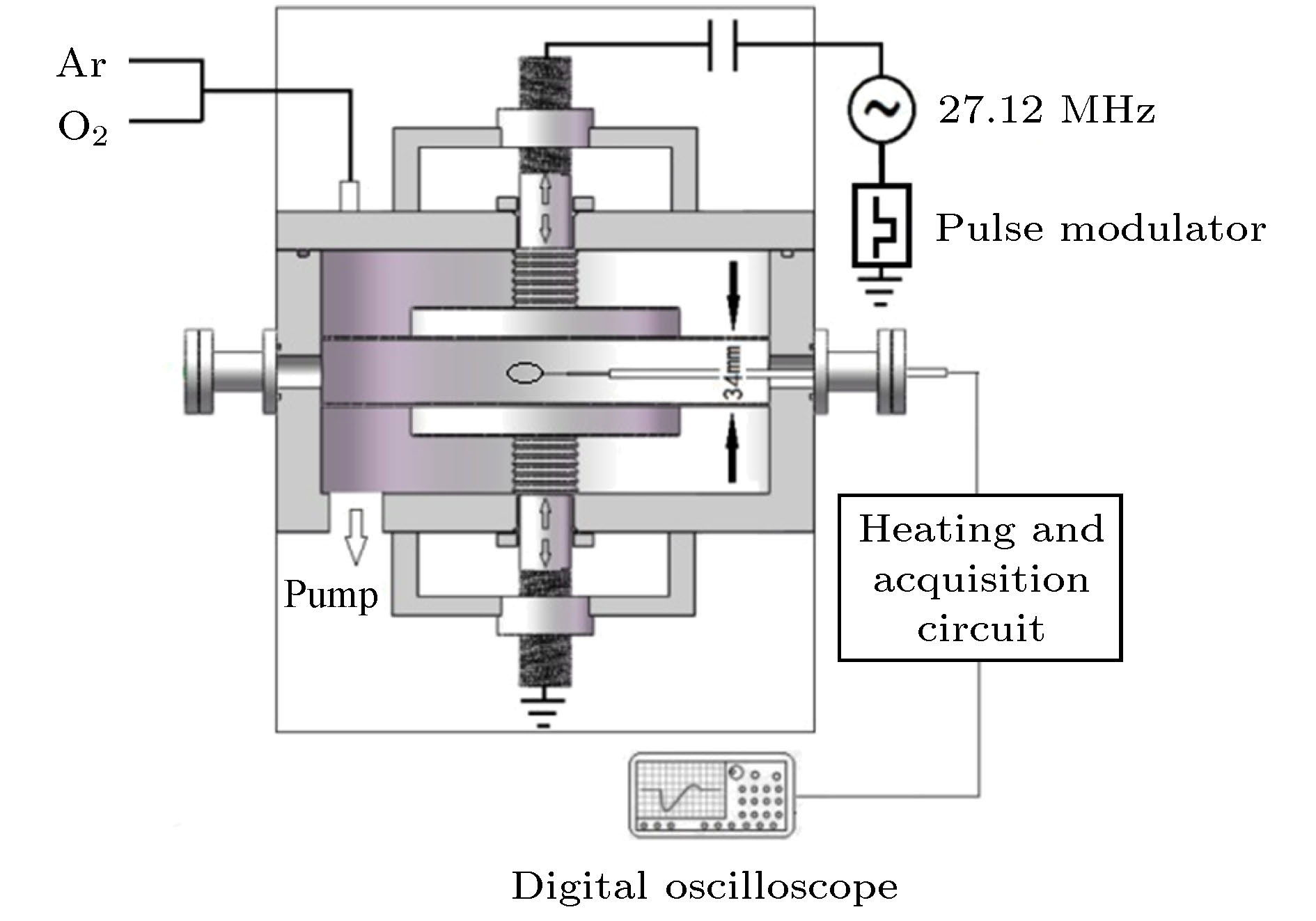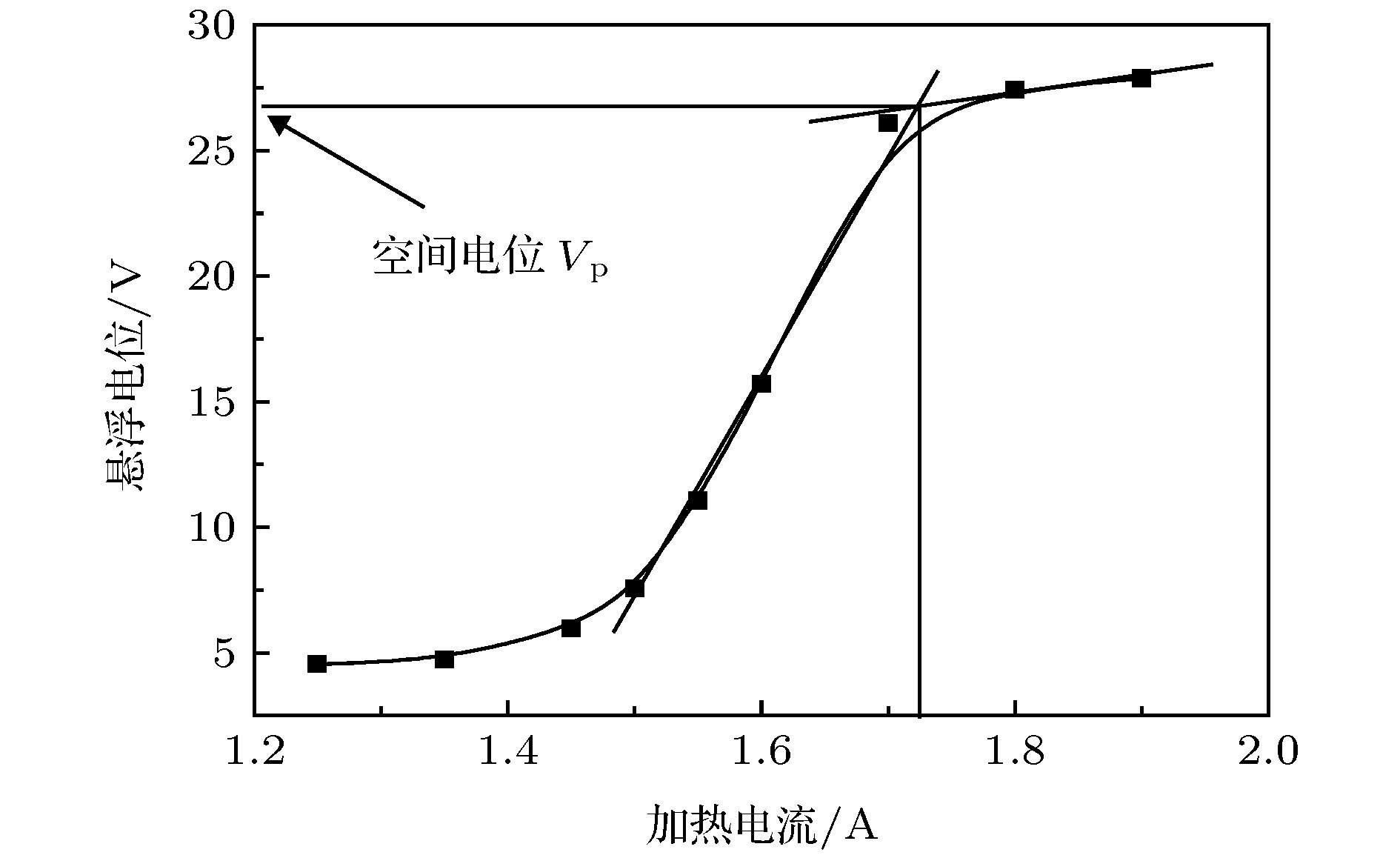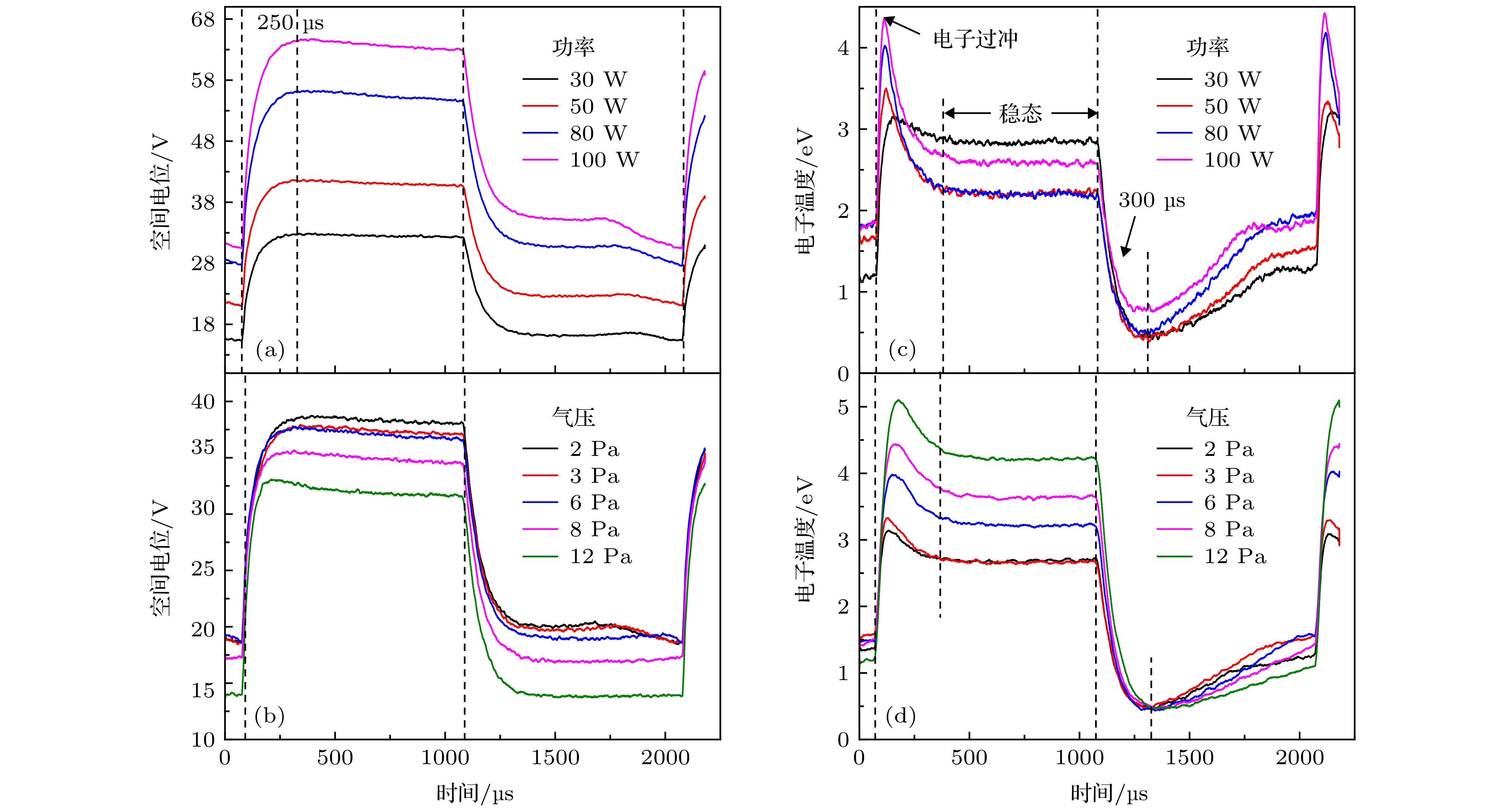-
利用工作在浮点模式下的发射探针, 对500 Hz脉冲调制的27.12 MHz容性耦合氩气等离子体的空间电位和电子温度的时变特性进行了诊断. 等离子体空间电位是通过测量强热状态下的发射探针电位获得的, 而电子温度则是由发射探针在冷、热状态下的电位差来估算得到. 测量结果表明: 脉冲开启时, 空间电位会快速上升并在300 μs内趋于饱和; 当脉冲关断后, 空间电位经历了快速下降后趋于稳定的过程. 电子温度在脉冲开启时存在过冲并趋于稳定的特征; 而在脉冲关断期间, 电子温度在300 μs内则快速下降到0.45 eV后略有上升. 无论在脉冲开启或关断期间, 空间电位基本上都随功率和气压的变化存在有线性的依赖关系; 而放电功率对脉冲开启期间过冲电子温度与稳态电子温度差异的影响较大. 针对空间电位和电子温度在各阶段及不同放电条件下的时变特性, 给出了相应的解释.There are several methods of diagnosing the capacitively coupled plasma, such as microwave resonance probe, Langmuir probe, etc, but methods like microwave resonance probe are mainly used for determining the electron density. Moreover, in the diagnosing of plasma potential, the emissive probe has a higher accuracy than the traditional electrostatic probes, and it can directly monitor the potential in real time. However, in the existing work, emissive probe is mostly applied to the diagnosis of plasmas with high density or plasmas modulated by pulsed dual frequency (one of the radio frequency sources is modulated), the experiments on the emissive probe diagonising plasma excited by a pulsed single frequency are quite rare. In this paper, the temporal evolution of the plasma potential and electron temperature with input power and pressure in a pulsed 27.12 MHz capacitively coupled argon plasma are investigated by using an emissive probe operated in floating point mode. The plasma potential is obtained by measuring emissive probe potential under a strongly heated condition, while the electron temperature is estimated from the potential difference between the emissive probe under strongly heating and cold conditions. The measurements show that as the pulse is on, the plasma potential will rise rapidly and become saturated within 300 μs due to the requirement for neutrality condition; while the pulse is off, the plasma potential undergoes a rapid decline and then stabilizes. An overshoot for the electron temperature occurs as the onset of the pulse, because of the influence of radio frequency electric field and residual electrons from the last pulse; during the pulse-off time, rapid loss of high-energy electrons causes the electron temperature to rapidly drops to 0.45 eV within 300 μs, then it rises slightly, which is related to the electrons emitted by the probe. The plasma potential basically has a linear dependence on the change of input power and pressure for the pulse-on and pulse-off time; and the input power has a greater influence on the difference between the overshoot electron temperature and the steady state electron temperature during the pulse-on time. Corresponding explanations are given for the temporal evolution of plasma potential and electron temperature in different pulse stages and under different discharge conditions.
-
Keywords:
- emissive probe /
- pulsed plasma /
- plasma potential /
- electron temperature
[1] 迈克尔·A·力伯曼, 阿伦·J·里登伯格 著 (蒲以康 译) 2007 等离子体放电原理与材料处理 (北京: 科学出版社) 第1−5页
Lieberman M A, Lichtenberg A J (translated by Pu Y K) 2007 Principles of Plasma Discharges and Processing (Beijing: Science Press) pp1−5 (in Chinese)
[2] Chang C Y, Sze S M 1996 McGraw-Hill Dictionary of Scientific and Technical Terms (New York: ULSI Technology) p329
[3] Hopwood J 1992 Plasma Sources Sci. Technol. 1 109
 Google Scholar
Google Scholar
[4] Kahoh M, Suzuki K, Tonotani J, Aoki K, Yamage M 2001 Jpn. J. Appl. Phys. 40 5419
 Google Scholar
Google Scholar
[5] Lieberman M A, Booth J P, Chabert P, Rax J M, TurnerM M 2002 Plasma Sources Sci. Technol. 11 283
 Google Scholar
Google Scholar
[6] Hebner G A, Barnat E V, Miller P A, Paterson A M, Holland J P 2006 Plasma Sources Sci. Technol. 15 879
 Google Scholar
Google Scholar
[7] Chabert P 2007 J. Phys. D: Appl. Phys. 40 R63
 Google Scholar
Google Scholar
[8] Lee I, Graves D B, Lieberman M A 2008 Plasma Sources Sci. Technol. 17 015018
 Google Scholar
Google Scholar
[9] Goto H H, Lowe H D, Ohmi T 1992 J. Vac. Sci. Technol., A 10 3048
 Google Scholar
Google Scholar
[10] Mishra A, Kim K N, Kim T H, Yeom G Y 2012 Plasma Source Sci. Technol. 21 035018
 Google Scholar
Google Scholar
[11] Samukawa S, Furuoya S 1993 Appl. Phys. Lett. 63 2044
 Google Scholar
Google Scholar
[12] Samukawa S, Mieno T 1996 Plasma Sources Sci. Technol. 5 132
 Google Scholar
Google Scholar
[13] Verdeyen J T, Beberman J, Overzet L 1990 J. Vac. Sci. Technol. A 8 1851
 Google Scholar
Google Scholar
[14] Howling A A, Sansonnens L, Dorier J L, Hollenstein C 1994 J. Appl. Phys. 75 1340
 Google Scholar
Google Scholar
[15] Wu H P, Tian Q W, Tian X B, Gong C Z, Zhang X Y, Wu Z Z 2019 Surf. Coat. Technol. 374 383
 Google Scholar
Google Scholar
[16] Sun X Y, Zhang Y R, Chai S, Wang Y N, He J X 2019 Phys. Plasmas 26 043503
 Google Scholar
Google Scholar
[17] Imamura T, Yamamoto K, Kurihara K, Hayashi H 2017 J. Vac. Sci. Technol., B 35 062201
 Google Scholar
Google Scholar
[18] Rahman M T, Hossain M M 2017 Phys. Plasmas 24 013516
 Google Scholar
Google Scholar
[19] Jeon M H, Park J W, Kim T H, Yun D H, Kim K N, Yeom G Y 2016 J. NanoSci. Nanotechnol. 16 11831
 Google Scholar
Google Scholar
[20] Liu R Q, Liu Y, Jia W Z, Zhou Y W 2017 Phys. Plasmas 24 013517
 Google Scholar
Google Scholar
[21] Thorsteinsson E G, Gudmundsson J T 2009 Plasma Sources Sci. Technol. 18 045002
 Google Scholar
Google Scholar
[22] Maresca A, Orlov K, Kortshagen U 2002 Phys. Rev. E 65 056405
 Google Scholar
Google Scholar
[23] Liu F X, Tsankov T V, Pu Y K 2015 J. Phys. D: Appl. Phys. 48 035206
 Google Scholar
Google Scholar
[24] Xue C, Wen D Q, Liu W, Zhang Y R, Gao F, Wang Y N 2017 J. Vac. Sci. Technol. A 35 021301
 Google Scholar
Google Scholar
[25] Wang E Y, Intrator T, Hershkowitz N 1985 Rev. Sci. Instrum. 56 519
 Google Scholar
Google Scholar
[26] Fujita H, Yagura S 1983 Jpn. J. Appl. Phys. 22 148
[27] Li J Q, Xu J, Bai Y J, Lu W Q, Wang Y N 2016 J. Vac. Sci. Technol. A 34 061304
 Google Scholar
Google Scholar
[28] Sheehan J P, Hershkowitz N 2011 Plasma Sources Sci. Technol. 20 063001
 Google Scholar
Google Scholar
[29] Langmuir I 1923 J. Franklin Inst. 196 751
 Google Scholar
Google Scholar
[30] Chen F F 1965 Electric Probes Plasma Diagnostic Techniques (New York: Academic) p184
[31] Sheehan J P, Barnat E V, Weatherford B R, Kaganovich D, Hershkowitz N 2014 Phys. Plasmas 21 013510
 Google Scholar
Google Scholar
[32] Mishra A, Seo J S, Kim K N, Yeom G Y 2013 J. Phys. D: Appl. Phys. 46 235203
 Google Scholar
Google Scholar
[33] Mishra A, Yeom G Y 2016 AIP Adv. 6 095101
 Google Scholar
Google Scholar
[34] Mishra A, Jeon M H, Kim K N, Yeom G Y 2012 Plasma Sources Sci. Technol. 21 055006
 Google Scholar
Google Scholar
[35] Mishra A, Kelly P J, Bradley J W 2011 J. Phys. D: Appl. Phys. 44 425201
 Google Scholar
Google Scholar
[36] Liebig B, Bradley J W 2013 Plasma Sources Sci. Technol. 22 045020
 Google Scholar
Google Scholar
[37] Piejak R B, Godyak V A, Garner R, Alexandrovich B M, Sternberg N 2004 J. Appl. Phys. 95 3785
 Google Scholar
Google Scholar
[38] Karkari S K, Ellingboe A R, Gaman C 2008 Appl. Phys. Lett. 93 071501
 Google Scholar
Google Scholar
[39] Chen F F, Chang J P 2002 Principles of Plasma Processing (Dordrecht/New York: Kluwer/Plenum) pp31–32
[40] Zhao Y F, Zhou Y, Ma X P, Cao L Y, Zheng F G, Xin Y 2019 Phys. Plasmas 26 033502
 Google Scholar
Google Scholar
[41] Karkari S K, Gaman C, Ellingboe A R, Swindells I, Bradley J W 2007 Meas. Sci. Technol. 18 2649
 Google Scholar
Google Scholar
[42] Welzel T, Dunger T, Leibig B, Richter F 2008 New J. Phys. 10 123008
 Google Scholar
Google Scholar
[43] Bradley J W, Karkari S K, Vetushka A 2004 Plasma Sources Sci. Technol. 13 189
 Google Scholar
Google Scholar
[44] Arslanbekov R R, Kudryavtsev A A 2001 Phys. Rev. E 64 016401
 Google Scholar
Google Scholar
[45] Liu F X, Guo X M, Pu Y K 2015 Plasma Sources Sci. Technol. 24 034013
 Google Scholar
Google Scholar
[46] You S D, Dodd R, Edwards A, Bradley J W 2010 J. Phys. D: Appl. Phys. 43 505205
 Google Scholar
Google Scholar
[47] Wenig G, Schulze M, Awakowicz P, Keudell A V 2006 Plasma Sources Sci. Technol. 15 S35
 Google Scholar
Google Scholar
[48] Poolcharuansin P, BradleyJ W 2010 Plasma Sources Sci. Technol. 19 025010
 Google Scholar
Google Scholar
-
图 2 连续波激发的容性耦合等离子体中测得的探针悬浮电位(Vf)与加热电流(Iht)的关系图, 测量在气压为3.0 Pa、射频功率为50 W的氩气等离子体中进行
Fig. 2. A plot of measured floating potential (Vf) versus heating current (Iht) in a CCP discharge in a continuous wave mode. The measurements were carried out at argon plasma with pressure of 3.0 Pa and input power of 50 W.
图 3 放电气压为3.0 Pa、脉冲射频功率为30 W氩气等离子体中, 发射探针测量得到的数据, 调制频率为500 Hz, 占空比50% (a)悬浮电位及空间电位的时变特性; (b) 电子温度的时变特性
Fig. 3. The data measured by an emissive probe in an argon plasma with a discharge pressure of 3.0 Pa and a pulsed RF power of 30 W: (a) Temporal evolution of floating potential and plasma potential; (b) temporal evolution of electron temperature. The discharge was pulsed at 500 Hz with 50% duty cycle.
图 4 不同放电条件下Vp和Te的时变特性(测量在频率为500 Hz, 占空比50%调制的氩气等离子体中进行) (a), (c) 在3 Pa不同功率条件下Vp和Te的时变特性; (b), (d) 在50 W不同气压条件下Vp和Te的时变特性
Fig. 4. A plot of temporal evolution of plasma potential and electron temperature: (a) plasma potential (Vp) with power (3 Pa); (b) plasma potential (Vp) with pressure (50 W); (c) electron temperature (Te) with power (3 Pa); (d) electron temperature (Te) with pressure (50 W). The measurements are carried out at argon plasma and the discharge is pulsed at 500 Hz with 50% duty cycle.
-
[1] 迈克尔·A·力伯曼, 阿伦·J·里登伯格 著 (蒲以康 译) 2007 等离子体放电原理与材料处理 (北京: 科学出版社) 第1−5页
Lieberman M A, Lichtenberg A J (translated by Pu Y K) 2007 Principles of Plasma Discharges and Processing (Beijing: Science Press) pp1−5 (in Chinese)
[2] Chang C Y, Sze S M 1996 McGraw-Hill Dictionary of Scientific and Technical Terms (New York: ULSI Technology) p329
[3] Hopwood J 1992 Plasma Sources Sci. Technol. 1 109
 Google Scholar
Google Scholar
[4] Kahoh M, Suzuki K, Tonotani J, Aoki K, Yamage M 2001 Jpn. J. Appl. Phys. 40 5419
 Google Scholar
Google Scholar
[5] Lieberman M A, Booth J P, Chabert P, Rax J M, TurnerM M 2002 Plasma Sources Sci. Technol. 11 283
 Google Scholar
Google Scholar
[6] Hebner G A, Barnat E V, Miller P A, Paterson A M, Holland J P 2006 Plasma Sources Sci. Technol. 15 879
 Google Scholar
Google Scholar
[7] Chabert P 2007 J. Phys. D: Appl. Phys. 40 R63
 Google Scholar
Google Scholar
[8] Lee I, Graves D B, Lieberman M A 2008 Plasma Sources Sci. Technol. 17 015018
 Google Scholar
Google Scholar
[9] Goto H H, Lowe H D, Ohmi T 1992 J. Vac. Sci. Technol., A 10 3048
 Google Scholar
Google Scholar
[10] Mishra A, Kim K N, Kim T H, Yeom G Y 2012 Plasma Source Sci. Technol. 21 035018
 Google Scholar
Google Scholar
[11] Samukawa S, Furuoya S 1993 Appl. Phys. Lett. 63 2044
 Google Scholar
Google Scholar
[12] Samukawa S, Mieno T 1996 Plasma Sources Sci. Technol. 5 132
 Google Scholar
Google Scholar
[13] Verdeyen J T, Beberman J, Overzet L 1990 J. Vac. Sci. Technol. A 8 1851
 Google Scholar
Google Scholar
[14] Howling A A, Sansonnens L, Dorier J L, Hollenstein C 1994 J. Appl. Phys. 75 1340
 Google Scholar
Google Scholar
[15] Wu H P, Tian Q W, Tian X B, Gong C Z, Zhang X Y, Wu Z Z 2019 Surf. Coat. Technol. 374 383
 Google Scholar
Google Scholar
[16] Sun X Y, Zhang Y R, Chai S, Wang Y N, He J X 2019 Phys. Plasmas 26 043503
 Google Scholar
Google Scholar
[17] Imamura T, Yamamoto K, Kurihara K, Hayashi H 2017 J. Vac. Sci. Technol., B 35 062201
 Google Scholar
Google Scholar
[18] Rahman M T, Hossain M M 2017 Phys. Plasmas 24 013516
 Google Scholar
Google Scholar
[19] Jeon M H, Park J W, Kim T H, Yun D H, Kim K N, Yeom G Y 2016 J. NanoSci. Nanotechnol. 16 11831
 Google Scholar
Google Scholar
[20] Liu R Q, Liu Y, Jia W Z, Zhou Y W 2017 Phys. Plasmas 24 013517
 Google Scholar
Google Scholar
[21] Thorsteinsson E G, Gudmundsson J T 2009 Plasma Sources Sci. Technol. 18 045002
 Google Scholar
Google Scholar
[22] Maresca A, Orlov K, Kortshagen U 2002 Phys. Rev. E 65 056405
 Google Scholar
Google Scholar
[23] Liu F X, Tsankov T V, Pu Y K 2015 J. Phys. D: Appl. Phys. 48 035206
 Google Scholar
Google Scholar
[24] Xue C, Wen D Q, Liu W, Zhang Y R, Gao F, Wang Y N 2017 J. Vac. Sci. Technol. A 35 021301
 Google Scholar
Google Scholar
[25] Wang E Y, Intrator T, Hershkowitz N 1985 Rev. Sci. Instrum. 56 519
 Google Scholar
Google Scholar
[26] Fujita H, Yagura S 1983 Jpn. J. Appl. Phys. 22 148
[27] Li J Q, Xu J, Bai Y J, Lu W Q, Wang Y N 2016 J. Vac. Sci. Technol. A 34 061304
 Google Scholar
Google Scholar
[28] Sheehan J P, Hershkowitz N 2011 Plasma Sources Sci. Technol. 20 063001
 Google Scholar
Google Scholar
[29] Langmuir I 1923 J. Franklin Inst. 196 751
 Google Scholar
Google Scholar
[30] Chen F F 1965 Electric Probes Plasma Diagnostic Techniques (New York: Academic) p184
[31] Sheehan J P, Barnat E V, Weatherford B R, Kaganovich D, Hershkowitz N 2014 Phys. Plasmas 21 013510
 Google Scholar
Google Scholar
[32] Mishra A, Seo J S, Kim K N, Yeom G Y 2013 J. Phys. D: Appl. Phys. 46 235203
 Google Scholar
Google Scholar
[33] Mishra A, Yeom G Y 2016 AIP Adv. 6 095101
 Google Scholar
Google Scholar
[34] Mishra A, Jeon M H, Kim K N, Yeom G Y 2012 Plasma Sources Sci. Technol. 21 055006
 Google Scholar
Google Scholar
[35] Mishra A, Kelly P J, Bradley J W 2011 J. Phys. D: Appl. Phys. 44 425201
 Google Scholar
Google Scholar
[36] Liebig B, Bradley J W 2013 Plasma Sources Sci. Technol. 22 045020
 Google Scholar
Google Scholar
[37] Piejak R B, Godyak V A, Garner R, Alexandrovich B M, Sternberg N 2004 J. Appl. Phys. 95 3785
 Google Scholar
Google Scholar
[38] Karkari S K, Ellingboe A R, Gaman C 2008 Appl. Phys. Lett. 93 071501
 Google Scholar
Google Scholar
[39] Chen F F, Chang J P 2002 Principles of Plasma Processing (Dordrecht/New York: Kluwer/Plenum) pp31–32
[40] Zhao Y F, Zhou Y, Ma X P, Cao L Y, Zheng F G, Xin Y 2019 Phys. Plasmas 26 033502
 Google Scholar
Google Scholar
[41] Karkari S K, Gaman C, Ellingboe A R, Swindells I, Bradley J W 2007 Meas. Sci. Technol. 18 2649
 Google Scholar
Google Scholar
[42] Welzel T, Dunger T, Leibig B, Richter F 2008 New J. Phys. 10 123008
 Google Scholar
Google Scholar
[43] Bradley J W, Karkari S K, Vetushka A 2004 Plasma Sources Sci. Technol. 13 189
 Google Scholar
Google Scholar
[44] Arslanbekov R R, Kudryavtsev A A 2001 Phys. Rev. E 64 016401
 Google Scholar
Google Scholar
[45] Liu F X, Guo X M, Pu Y K 2015 Plasma Sources Sci. Technol. 24 034013
 Google Scholar
Google Scholar
[46] You S D, Dodd R, Edwards A, Bradley J W 2010 J. Phys. D: Appl. Phys. 43 505205
 Google Scholar
Google Scholar
[47] Wenig G, Schulze M, Awakowicz P, Keudell A V 2006 Plasma Sources Sci. Technol. 15 S35
 Google Scholar
Google Scholar
[48] Poolcharuansin P, BradleyJ W 2010 Plasma Sources Sci. Technol. 19 025010
 Google Scholar
Google Scholar
计量
- 文章访问数: 12203
- PDF下载量: 160
- 被引次数: 0














 下载:
下载:




